Huernia Succulents 101: 46 Types and Care Instructions
If you’re a fan of stunning flowers, you definitely don’t want to miss out on the Huernia plant. What makes this plant truly special are its captivating deep red flowers. Imagine the perfect blend of cream and red hues, topped off with a glossy, rubbery texture. These flowers are absolute eye-catchers that will leave your visitors in awe. Get ready to bring home a plant that’s not only beautiful but also a conversation starter.
Contents
- 1 Types of Huernia
- 1.1 Huernia aspera
- 1.2 Huernia barbata
- 1.3 Huernia guttata
- 1.4 Huernia hislopii
- 1.5 Huernia humilis
- 1.6 Huernia hystrix
- 1.7 Huernia kennedyana
- 1.8 Huernia levyi
- 1.9 Huernia loeseneriana
- 1.10 Huernia longii
- 1.11 Huernia longituba
- 1.12 Huernia macrocarpa
- 1.13 Huernia namaquensis
- 1.14 Huernia occulta
- 1.15 Huernia oculata
- 1.16 Huernia pendula
- 1.17 Huernia piersii
- 1.18 Huernia pillansii
- 1.19 Huernia plowesii
- 1.20 Huernia praestans
- 1.21 Huernia procumbens
- 1.22 Huernia quinta
- 1.23 Huernia schneideriana
- 1.24 Huernia stapelioides
- 1.25 Huernia thuretii
- 1.26 Huernia transvaalensis
- 1.27 Huernia verekeri
- 1.28 Huernia volkartii
- 1.29 Huernia whitesloaneana
- 1.30 Huernia zebrina
- 2 How to Care For Huernia Succulents
- 3 How to Propagate Huernia
- 4 FAQs
Types of Huernia
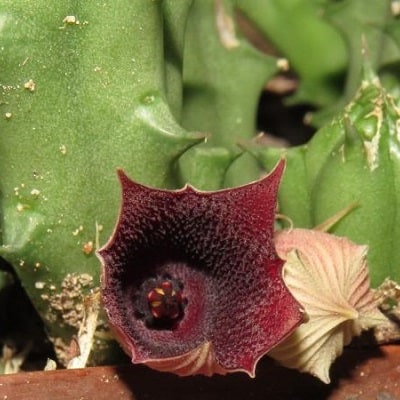
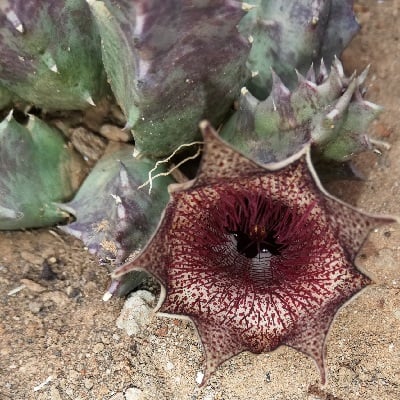
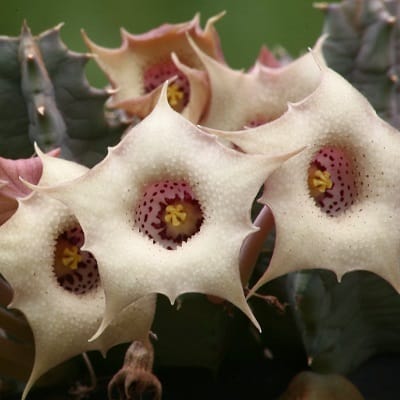
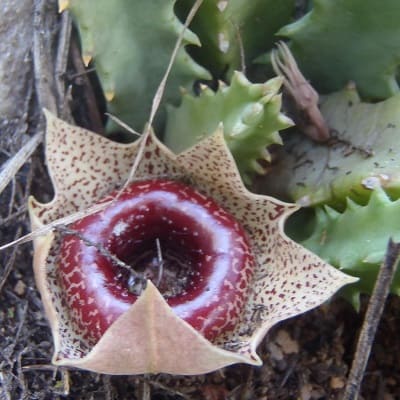
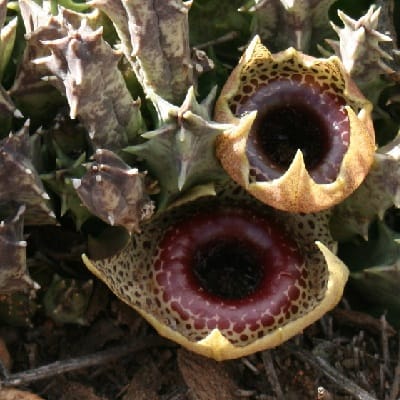
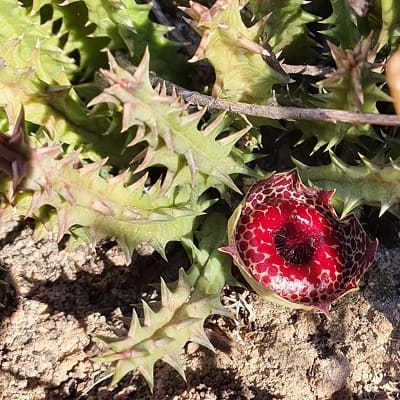
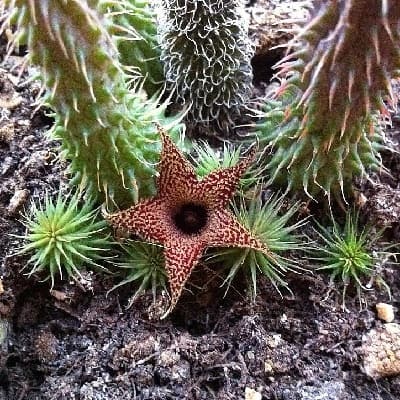
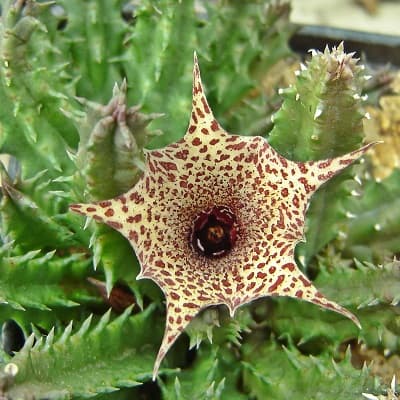
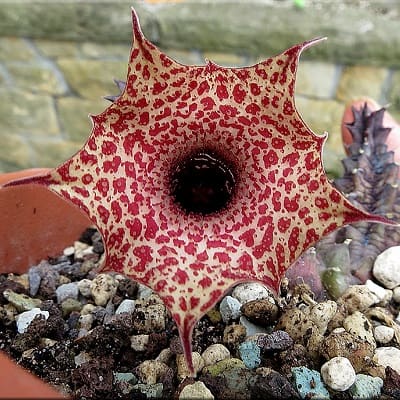
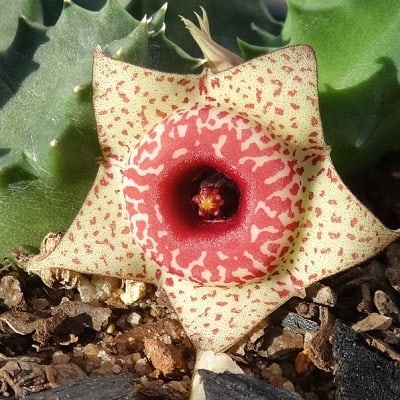
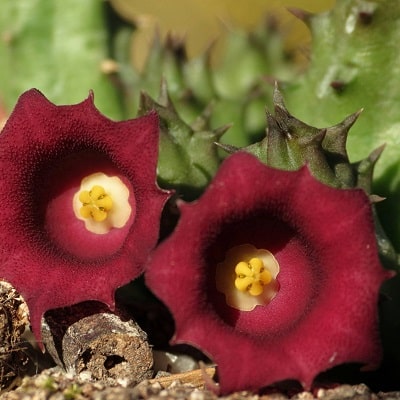
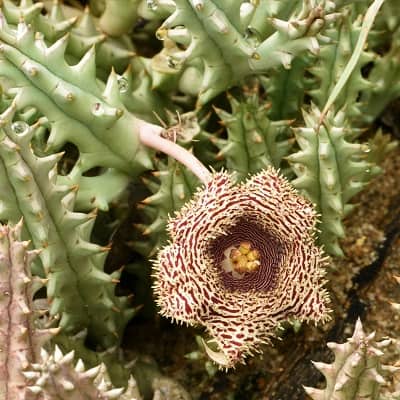
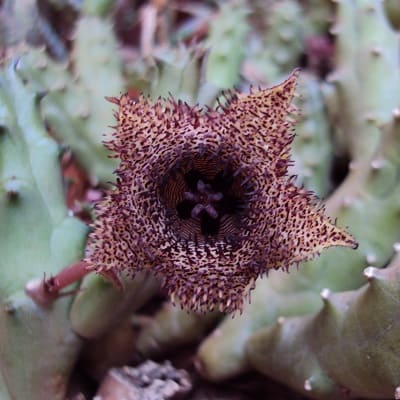
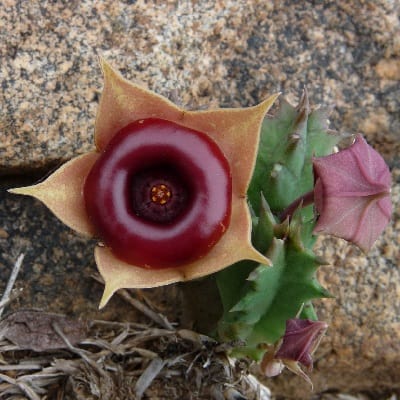
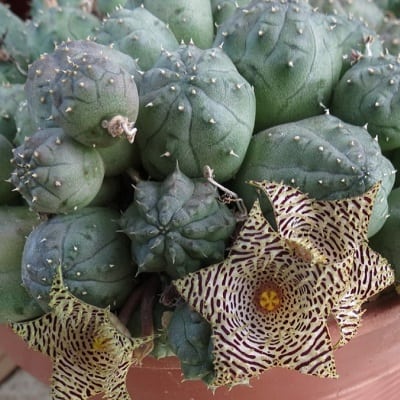
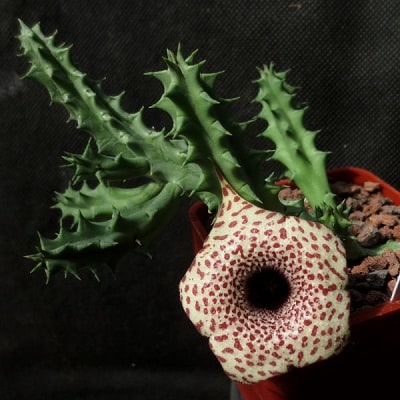
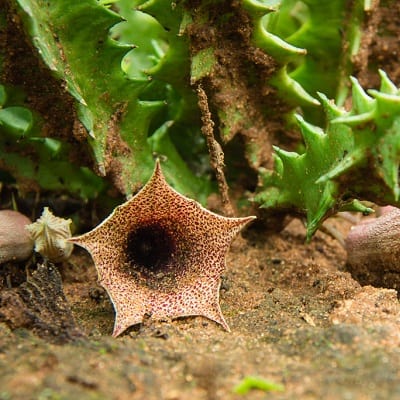
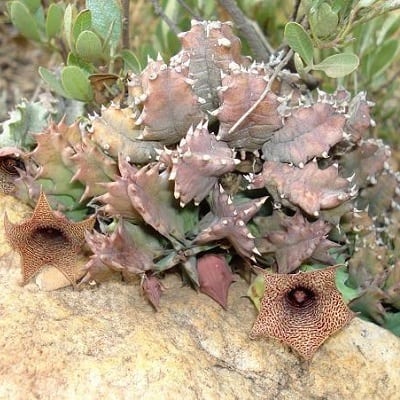


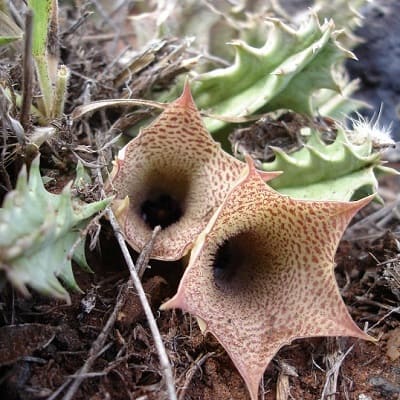
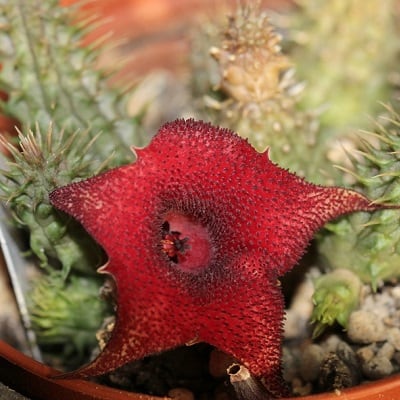
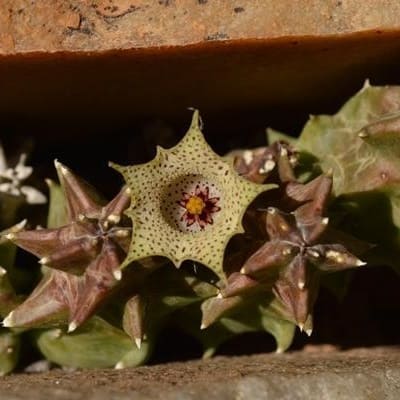
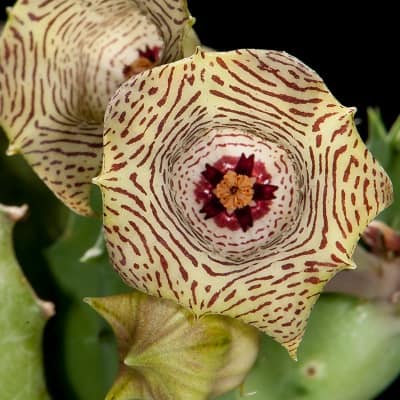
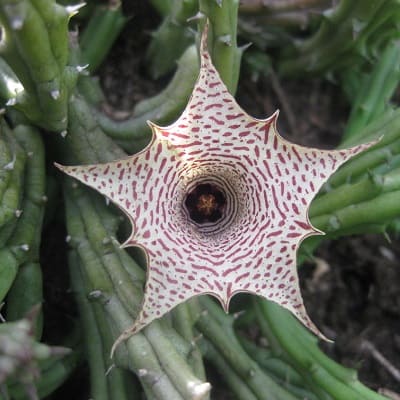
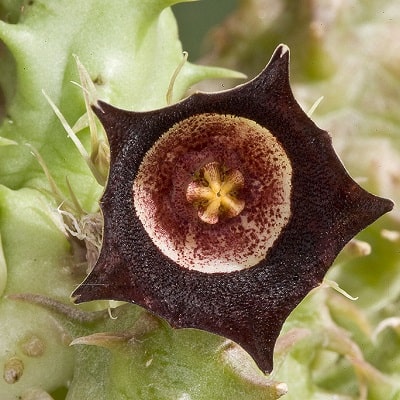
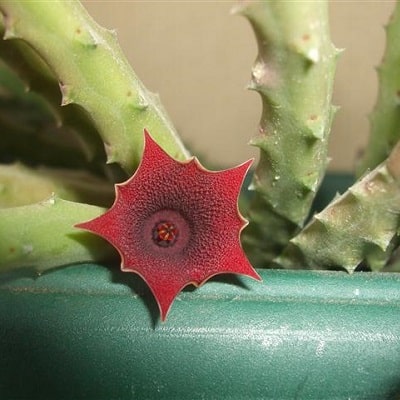
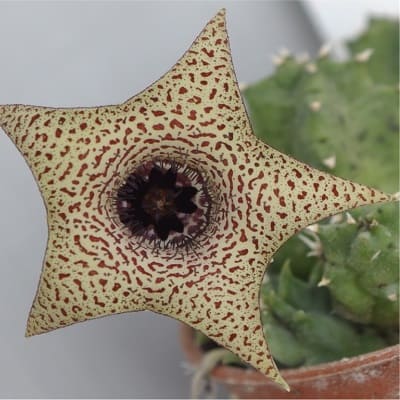
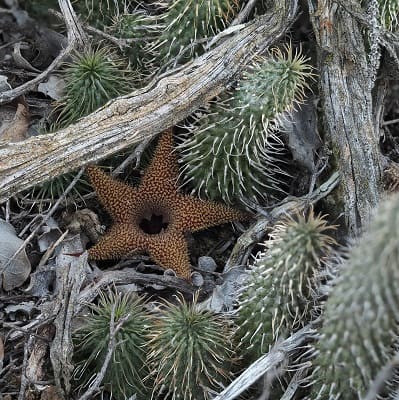
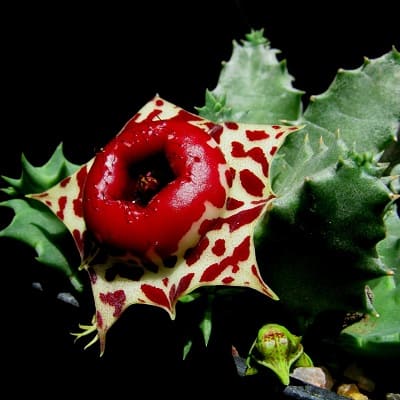
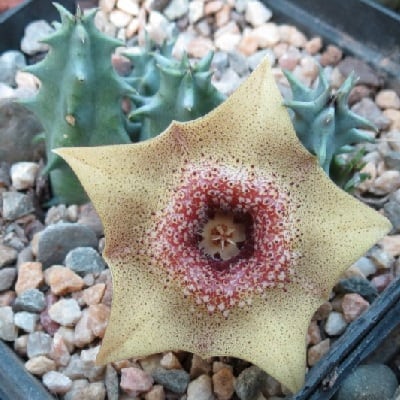
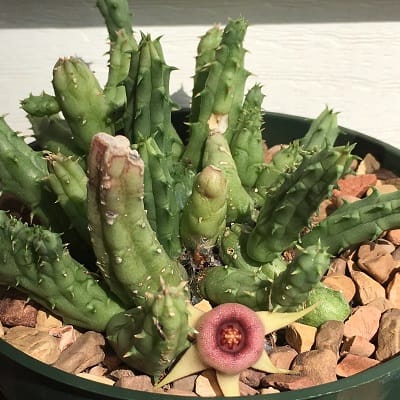
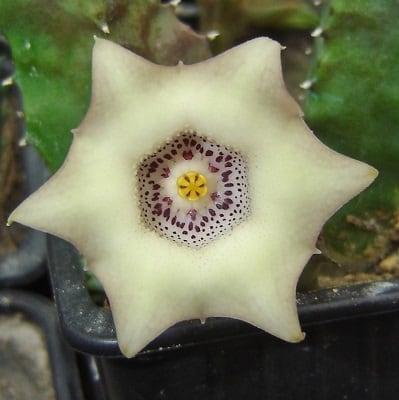
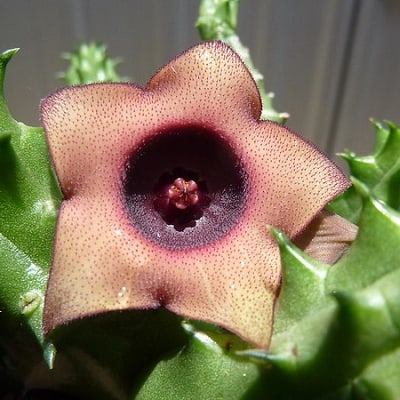
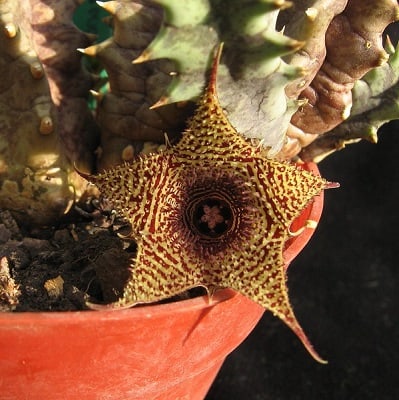
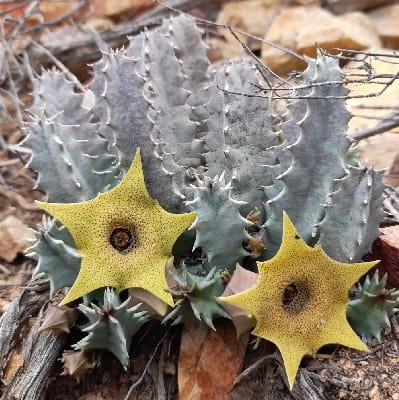
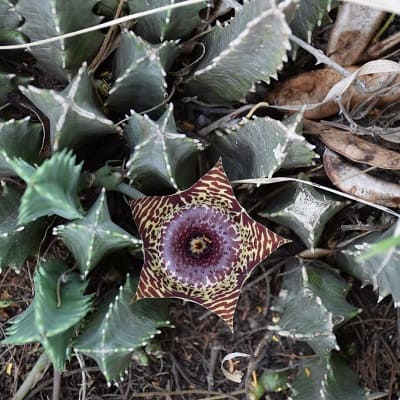
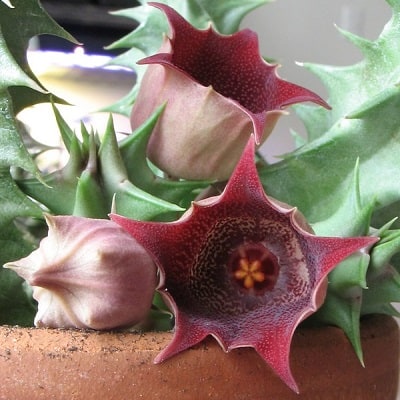
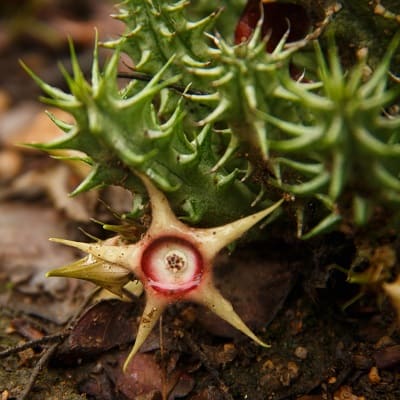
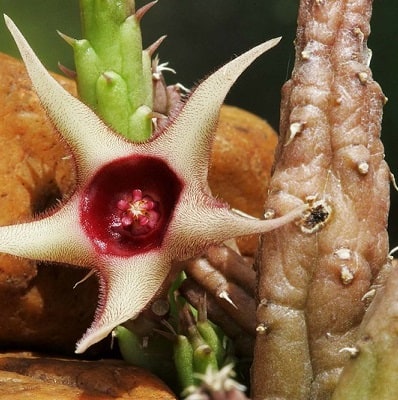
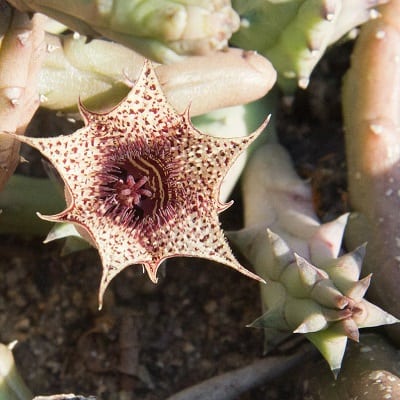
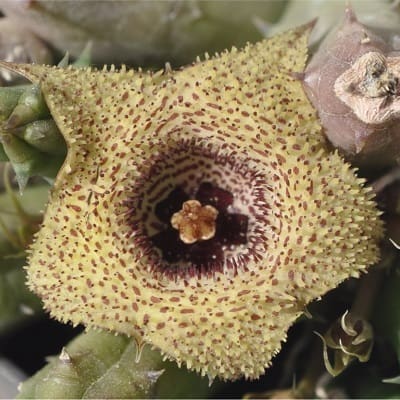
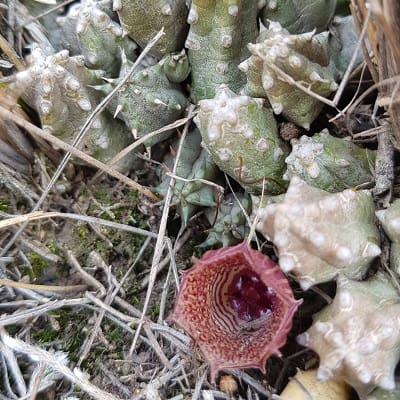

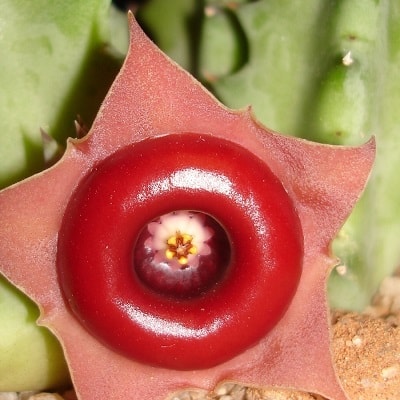
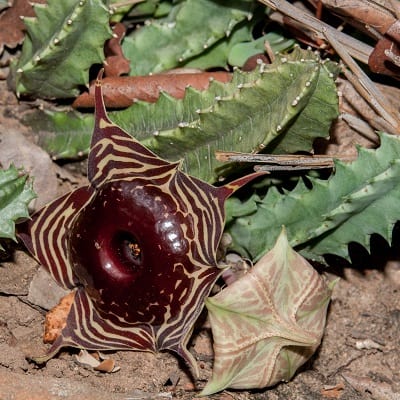
Related Post:
1,000 Types of Succulents With Pictures
Huernia aspera

This small succulent has creeping stems and beautiful dark purple bell-shaped flowers. The flowers have a unique papillate appearance and emit a foetid odor to attract flies for pollination.
Huernia barbata

With leafless succulent stems forming dense clumps, Huernia barbata showcases creamy urn-shaped flowers. The flowers have triangular lobes and a tube marked with delicate maroon speckling. They also feature long stiff purple hairs in the mouth of the tube, giving them an enchanting charm.
Huernia guttata

This tufted perennial succulent has upright, thick, toothed stems. Its 5-lobed flowers appear in groups of 2 to 4 at the base of new shoots. The bell-shaped corolla has a shiny convex fleshy ring in the center, with yellow and crimson dots. The markings on the annulus are variable, and the tube and stems exhibit unique characteristics.
Huernia guttata subsp. calitzdorpensis

This local or morphological form of Huernia guttata has larger and darker flowers, with a dark maroon tube marked by faint yellowish lines. The throat of the tube has longer and more clavate hairs.
Huernia hislopii

Known as the “dragon flower,” this succulent consists of tufted leafless stems with fleshy thorn-like points. The flowers do not emit a carrion smell like some related species. They bloom from spring to winter and vary in size and shape.
Huernia hislopii subsp. cashelensis

This subspecies of Huernia hislopii has long tubed flowers similar to Huernia longituba. The stems are more robust with 5-7 ribs, and the corona shows less clavate inner lobes.
Huernia hislopii subsp. robusta

Similar to standard Huernia hislopii, this subspecies has more robust stems with 5-7 ribs and longer, weakly inflated tubes. The lobes of the corolla are shorter and rarely acuminate.
Huernia humilis

This small compact succulent stands out with its dramatic colors. The flowers have a fleshy rose doughnut-shaped annulus in the center, yellow lobes with small maroon spots, and a maroon tube. The stems are short and tapered towards the apex.
Huernia hystrix

An intriguing tufted species with five-angled stems, Huernia hystrix features cup-shaped flowers with spiny petals. The flowers are yellow with red bands but can vary in color. Huernia hystrix subsp. hystrix has more vigorous stems and larger flowers.
Huernia hystrix subsp. parvula

This distinctive subspecies has shorter stems, smaller flowers with shorter papillae, and less expanded inner corona lobes.
Huernia kennedyana

Also known as the “Humpty Dumpty Huernia,” this perennial succulent has small highly papillose yellow flowers. It forms globular or egg-shaped stems that spread like a mat on the ground.
Huernia levyi

Huernia levyi forms fleshy clumps with greyish-green stems branching near the base. The stems are nearly erect, 4-angled, and armed with prominent teeth. The flowers are elongated, cream-colored, heavily speckled with burgundy, and have short flared lobes.
Huernia loeseneriana

This easily-flowering species has beige to light yellow flowers with delicate maroon markings resembling leopard spots on the petal lobes.
Huernia longii

Huernia longii has ribbon-like inner-corona lobes, thin tips swollen, and diverging or meeting each other. It can have subspecies with different variations.
Huernia longii subsp. echidnopsoides

This subspecies is smaller than Huernia pillansii and has more slender stems with fewer teeth. The flowers are smaller with wider corolla lobes, shorter papillae, and different inner corona lobes.
Huernia longituba

This richly branched species features erect stems with four or five angles. The stems have short teeth and can be light green or tinted with purple. The bell-shaped flowers appear singly or in groups of 2 or 3 at the base of the stems. The flowers have a considerably longer tube than other species, with triangular, sharply acute corolla lobes. The interior of the flowers is creamy yellow with red spots and spherical warts on the base of the tube.
Huernia macrocarpa

This easily flowered succulent species produces bell-shaped flowers in autumn. The flowers are mostly dark purple with recurved petal tips, but they can vary in color and size.
Huernia namaquensis

Known as the Namaqua Carrion Flower, this low-growing succulent exhibits upright shoots that root where they touch the ground. It lacks leaves and relies on its stems for photosynthesis. The flowers are whitish-yellow dotted with red and can vary in size and shape.
Huernia occulta

Similar to Huernia hislopii, this sprawling stem succulent can be distinguished by its long and slender, creeping stems that root when they touch the soil. The flowers are cream-colored with tawny red spots on the limb and lobes.
Huernia oculata

This unique species is often referred to as the “eye flower” due to its remarkable flowers. The corolla is blackish-purple velvety with a pure white center, resembling an eye. It is closely related to Huernia hislopii.
Huernia pendula

Standing out with its irregularly branched shoots, Huernia pendula features stems that lean back, creep, or hang down from cliffs. The small bell-shaped purple flowers with triangular lobes appear from spring to midsummer. It is also known as “Bootlace.”
Huernia piersii

This tufted, perennial succulent is distinguished by its creamy-white flowers marked with small dark red or brownish-crimson spots. The flowers are thinly bearded with long outstanding dark crimson clavate hairs in the throat and around the mouth of the tube.
Huernia pillansii

Considered one of the most distinct species, Huernia pillansii features bristle-covered stems that resemble miniature Hoodia plants. The star-like blooms are noteworthy and somewhat similar to those of Huernia hystrix.
Huernia plowesii

This extremely neat species has star-shaped flowers with a distinctive pattern. The flowers may not be large but the solid purple-brown annulus with cream-colored marks on its outer edge makes them visually striking.
Huernia praestans

This small perennial succulent species has short, purple and green mottled acutely-angled stems. The showy flowers are relatively large and appear at the stem base. The corolla is greenish-yellow with small purple dots, and the disc has large creamy papillae tipped with stout purple hairs.
Huernia procumbens

An intriguing succulent herb, Huernia procumbens consists of reptile-like sinuous stems that trail close to the ground. The flowers appear in inflorescences at the base of the young shoots, having a chestnut-brown glabrous annulus and cream to earth-colored corolla lobes.
Huernia quinta

This variable succulent species forms tuft-like clumps and produces attractively marked creamy-white flowers. The flowers are banded with dark red and display similar coloring on the reverse.
Huernia schneideriana

This attractive species was initially thought to be a natural hybrid but is now recognized as a distinct species. The flowers are burgundy, almost black inside the tube, and velvety. It closely resembles Huernia macrocarpa.
Huernia stapelioides

This clump- or carpet-forming species has four-angled stems and produces tubular flowers with narrow, circular bands of dark red along the entire length of the tube. The corolla lobes are yellow-red, mottled, and end in an acute point. The flowers open flat initially but then curl back after a couple of days.
Huernia thuretii

A tufted species with erect stems, Huernia thuretii varies in the size and shape of its flowers. The cup-shaped flowers have dull yellow petals marked with red spots or bands and a maroon throat.
Huernia transvaalensis

Also known as the “Transvaal Huernia,” this succulent features pinkish-grey stems with darker markings. The stems can form loose clumps or carpets. The flowers are star-shaped, ranging from pale yellow to cream, with purple patches of irregular shape and size, unlike the regular patterns seen in Huernia zebrina or Huernia guttata.
Huernia verekeri

This pretty and widespread tropical species features 5- to 7-angled stems closely set with narrow soft teeth. The perennial plant produces an abundance of star-like flowers that develop successively. The flowers are creamy to pinkish on the outside of the tube, purple-maroon around the circular rim of the wide shallow mouth, and white towards the base. The corona is suborbicular, and the inner lobes are incumbent on but not as long as the anthers.
Huernia verekeri subsp. angolensis

This subspecies is distinguished by its stems that bend outwards and downwards, with bluntly ribbed small tubercles. The corolla tube is entirely dark red inside, and the corona is reddish.
Huernia volkartii

Often referred to as the “Dragon flower,” this succulent forms clumps or carpets with globular or egg-shaped stems. The stems are green during the rainy season and turn reddish-brown in the dry winter months. The flowers are small and highly papillose, with yellow petals. It spreads like a mat across the ground.
Huernia volkartii var. repens

Distinguished by longer creeping stems with reduced stem teeth and deciduous leaf rudiments, this variety showcases flowers that are identical to many of those in Huernia volkartii.
Huernia whitesloaneana

An attractive miniature species growing in colonies, Huernia whitesloaneana features purplish-green stems with rounded projections. The flowers are tiny, bell-shaped, creamy-white, banded with dark red, and exhibit similar coloring on the reverse. They emit a foul smell.
Huernia zebrina

Also known as “Owl eyes,” this low-growing perennial succulent can form mats and creeper-like growth. The flowers have a raised, glossy wine-red ring or annulus around the mouth of the corolla tube. The corolla is usually patterned with wine-red zebra stripes of varying intensity.
Huernia zebrina subsp. insigniflora

This subspecies of Huernia zebrina features grayish-green stems with rounded projections and shorter teeth. The flowers are wider and have a dark red annulus at the center, resembling a lifebuoy. The corolla lobes can be mottled or barred and are shortly pubescent.
Huernia zebrina subsp. magniflora

Distinguished by larger flowers, often reaching up to 85mm in diameter, this subspecies has irregularly branching, taller stems. The flowers of Huernia zebrina subsp. magniflora exhibit the characteristic wine-red zebra stripes and glossy raised annulus.
How to Care For Huernia Succulents
Huernia succulents, also known as lifesaver cacti, are stunning plants that are relatively easy to care for. Follow these simple care tips to keep your Huernia thriving:
Soil
Choose a well-draining soil and pot for your Huernia. Unglazed pots are recommended as they allow moisture to escape. A cactus potting mix provides excellent drainage and keeps your succulent healthy.
Watering
Huernia succulents prefer sporadic watering. During the summer, only water when the top layer of soil appears dry. In winter, when the plant is dormant, water just once a month.
Fertilizing
During the summer growing season, fertilize your Huernia once a month using a light fertilizer. Stop fertilizing in fall and winter when the plant is dormant.
Light
Huernia varieties demand proper lighting to grow well. Avoid exposing them to direct sunlight, as it can lead to rot and disease. If the plant remains glossy, supple, and green with deep red flowers, it’s receiving adequate sunlight.
Pest and Diseases
Overwatering can cause rot in Huernia stems. Look for dark spots on the stems, indicating rot. If you notice an infestation, cut off the affected parts or use an insecticide to address bugs and rot.
How to Propagate Huernia
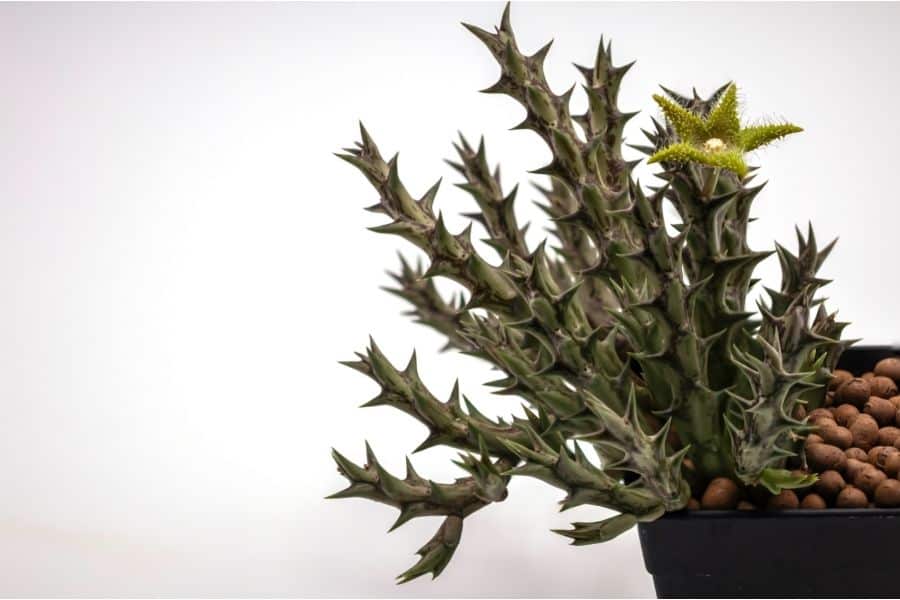
- Select a healthy, mature Huernia plant from which to take a stem cutting.
- Using clean and sharp gardening shears, cut a stem from the main plant. Aim for a section that is at least a few inches long.
- Allow the cut end of the stem to dry on a clean towel or in a shaded area for a few days. This drying period helps to prevent the cut end from rotting when it is planted.
- Prepare a small pot filled with fresh cactus mix or a well-draining soil blend.
- Create a small hole in the soil using your finger or a pencil.
- Gently place the dried end of the stem cutting into the hole and cover it with soil, ensuring the cutting is stable.
- Mist the soil lightly with water to settle it around the cutting.
- Place the pot in a location that receives bright, indirect sunlight. Avoid direct sunlight, as it can be too intense for the young cutting.
- Water the cutting sparingly, keeping the soil slightly damp but not overly wet. Overwatering can cause the cutting to rot.
- Monitor the cutting regularly, providing it with proper care and attention. Over time, the cutting will develop roots and begin to grow into a new Huernia plant.
Remember, patience is key when propagating Huernia. It may take a few weeks or even months for the cutting to establish roots and start growing. Keeping the environment warm, providing indirect sunlight, and avoiding overwatering will increase the chances of successful propagation.
FAQs
Here are a couple of frequently asked questions on Huernia varieties that we have curated just for you.
How do you get Huernia to bloom?
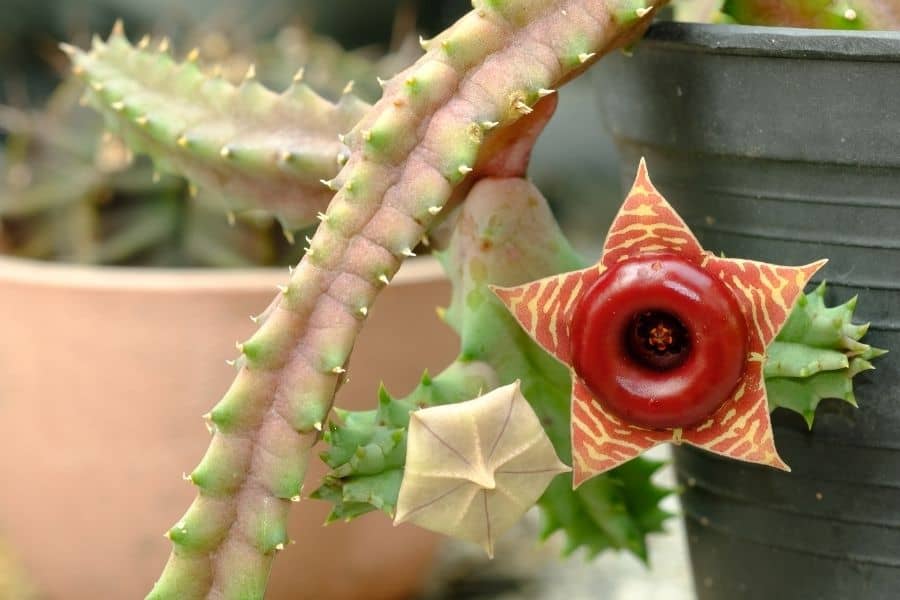
To encourage Huernia to bloom, ensure it has a well-drained container, good potting mix, sporadic diluted light fertilizer, optimum light exposure, and adequate watering. Meeting these basic needs will support healthy growth and blooming.
Is Huernia a cactus?
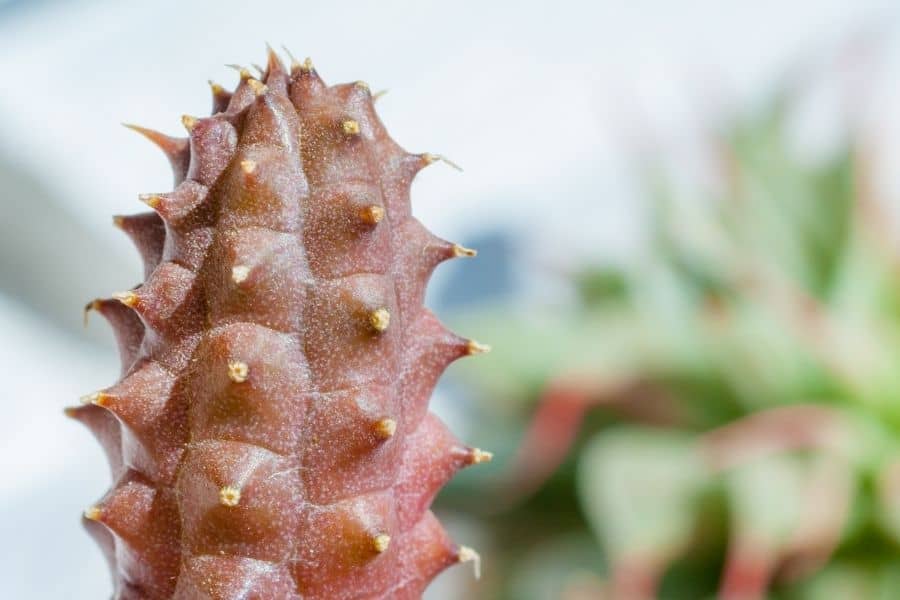
Huernia is not technically a cactus, although it is often referred to as a lifesaver cactus or succulent. It shares similarities with cacti in terms of appearance and care requirements.
